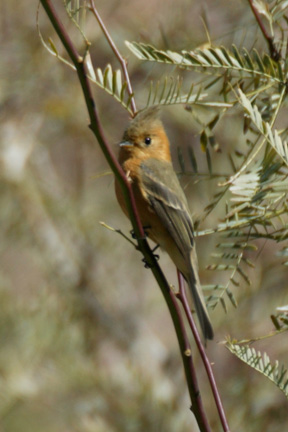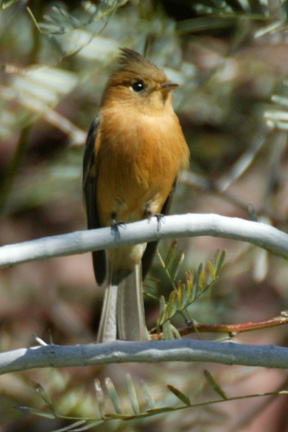Discovery: First Occurrence of Tufted Flycatcher in Arizona
Mark M. Stevenson
Steven and Julie Servantez were visiting Las Vegas to attend a veterinary conference. Being from Wisconsin and being amateur birders interested in photography, they were looking for opportunities to experience western birds, particularly the Burrowing Owl. At the Lake Meade National Recreation Area information center they asked about the owls. The person they spoke with said that there were no Burrowing Owls in Nevada, then gave them a map to White Rock Canyon, saying how beautiful it was with hot springs and the potential for Red-tailed Hawk or eagle sightings. Not exactly novel avian fare for Wisconsinites, but they decided to take the hike.
On February 24, 2005, from the trailhead northwest of Kingman, AZ they hiked down through the rugged, sparsely vegetated canyon to its mouth at Lake Mohave on the Colorado River. In a mesquite tree near the riparian zone at the mouth of the canyon, Steven spotted a flycatcher and made a note of it before continuing on toward the hot springs. Being tired, they decided to turn back after a few hundred yards. But he had hauled 25 pounds of photo equipment down the canyon and was “determined to take a picture of a bird, ANY bird.” After relocating two flycatchers in a leafy mesquite, he took about a dozen shots of the brighter of the two. Then they watched the birds fly catch for another 10-15 minutes. After that, they hiked back out to the car and forgot about the little flycatcher.
By chance the next day they spotted a sign for the Henderson Bird Viewing Preserve and Water Reclamation Facility near Las Vegas and decided to stop in. While there, they began talking with Je Anne Branca and asked her about Burrowing Owls. She told them where to look for them. Already that winter, Steven and Julie had been to Duluth, MN to see the irrupting owls and, still having some owl photos on the memory card, showed them to Je Anne. The flycatcher photos were on the same card and they asked her to help them identify the local bird. She didn’t recognize the bird, nor did another birder who happened by. Steven and Julie went on their way and tracked down the Burrowing Owls, providing their biggest avian thrill of the trip.
A few days after they returned to Wisconsin, Steven got a call at the veterinary hospital from Je Anne, asking if he still had the photos. He hadn’t gone through the images yet so he hadn’t deleted the not-quite-sharp flycatcher photos. This was a good thing since Je Anne told him he’d captured a Tufted Flycatcher, only the third time the species has been seen north of Mexico! Not even depicted in field guides for the U.S., she’d discovered its identity by searching the web. It was a species he wasn’t even aware of.
Needless to say, the recognition of the bird in the photos generated a lot of excitement. Las Vegas area birders contacted Arizona birders and quickly made their plans to search for the bird. They hiked down into the canyon and searched the trees without success. Another expedition of birders searched along the river by boat from Willow Beach to Hoover Dam without luck. But they did note that, while many mesquites weren’t leafed out, some of those at the mouth of White Rock Canyon were, apparently a microclimate effect. The Tufted Flycatcher was never seen again. Via the Nevada birders, Steven forwarded his photos and a write-up of the observation to the Arizona Bird Committee for evaluation.
The subject of this serendipitous story, the Tufted Flycatcher Mitrephanes phaeocercus is a distinctive, widespread resident species on both slopes of Mexico from central Sonora and southern Tamaulipas south to Bolivia (Howell & Webb 1995). In Sonora, it reaches north to the Yecora region (Russell & Monson 1998). There it is a resident species, but does undertake altitudinal migrations, spending March-October in upper-elevation pine-oak woodland while wintering in well-wooded river bottoms (Russell & Monson 1998). North of Mexico, there are only two accepted records of the Tufted Flycatcher, both from Texas (ABA Checklist Committee 2002). The first was a bird photographed in Big Bend N.P. 3 November, 1991-17 January 1992 (American Birds 46:167) and the other was a bird photographed 47 miles west of Fort Stockton 2-6 April 1993 (American Birds 47:432).
The relatively small size, cinnamon face, throat and underparts, pale eyering and jaunty crest create the distinctive appearance of this species and make it readily identifiable by those familiar with it. The upperparts are brownish olive. The wings and tail are darker with two dull cinnamon wing bars. The folded wing shows whitish to lemon-colored tertial edgings and secondary panel. The bill is blackish above and orange below while the legs are black. The sexes are similar and there is slight age difference (Howell & Webb 1995).
Although Tufted Flycatchers nest near enough to Arizona to make it a not-unexpected vagrant, and its distribution in Sonora is similar to the Blue Mockingbird (another altitudinal migrant which has appeared at least twice in the state) I doubt that anyone would have expected it to appear as far to the northwest as this bird was discovered. Questions about the origins of such wayward birds often arise, as they should if it is to become part of the ornithological record. Could it be an escaped cage bird? That seems unlikely as flycatchers would make poor pets, having a specialized diet. Were there really established leaves on the mesquite trees where it was reported? I questioned the Nevada birders and others who visited the area to search for the bird in the days following the report and they confirmed the presence of such vegetation at this site despite its absence in nearby areas (Caroline Titus, personal communication).
This record was accepted by the Arizona Bird Committee as the first record of this species for the state (in litt).
Acknowledgements: I relied on emails from Steven Servantez for details of the narrative aspects of this article and incorporated material directly from them. Je Anne Branca and Caroline Titus provided additional information.
ABA Checklist Committee. 2002. ABA Checklist, 6th Edition. American Birding Association, Colorado Springs.
Howell, S.N.G. and S. Webb. 1995. A Guide to the Birds of Mexico and Northern Central America. Oxford University Press, New York.
Russell, S.M. and G. Monson. 1998. The Birds of Sonora. University of Arizona Press, Tucson.
Learn more about the Henderson Bird Viewing Preserve at:
http://www.ci.henderson.nv.us/parks/parks/bird_preserve.php
See the Texas records at: http://texasbirds.org/tbrc/tuftfly.htm
Postscript: At any given time, more than a few “vagrant” birds are probably around in any given state. Most of them likely go undiscovered and unreported. Yet many are found, identified and documented. It’s easy to imagine that intrepid experts with vast skill and experience are the ones who will turn up all the rare birds. While chance does favor the prepared mind, the most important factor in finding rarities is often simply getting out there and looking for birds.
|



